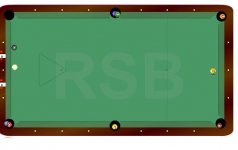A shot I have seen professionals practicing on several occasions is the one shown in the diagram below, and I have seen many different approaches to this shot over the years.
For the moment, let's consider the matter of all possible ways of making the eight and getting good shape on the nine, deferring the matter of what's the best way for later in the thread.
Clarifying the diagram, and it's vital that you understand this: 1) neither the cue ball nor the eight ball is frozen to the rail, 2) each ball is just off the rail, and you have no angle, meaning that both a center ball follow and a center ball draw would lead to a scratch in one of the bottom corners, 3) you are on fairly tight (but not ridiculouasly tight) equipment, so you can't cheat the pocket with much confidence of making the ball, 4) wei code text here is
START(%A[3\8%B[3B2%CB6\3%DB0\0%Et5B9%F[9B4%Gs8\5%HC8J2%Ir3O7%PC9N8)END
How many different ways of getting this shape do you know? Remember, I'm not asking how you'd shoot it, just about what you see as the theoretically possible ways of getting good on the nine here. By the way, I know the two rail eight in the side is one possible way, but to protect us from the incredibly creative bank-pool supergeeks, let's, for now, agree to ignore all banks of the eight here.
For the moment, let's consider the matter of all possible ways of making the eight and getting good shape on the nine, deferring the matter of what's the best way for later in the thread.
Clarifying the diagram, and it's vital that you understand this: 1) neither the cue ball nor the eight ball is frozen to the rail, 2) each ball is just off the rail, and you have no angle, meaning that both a center ball follow and a center ball draw would lead to a scratch in one of the bottom corners, 3) you are on fairly tight (but not ridiculouasly tight) equipment, so you can't cheat the pocket with much confidence of making the ball, 4) wei code text here is
START(%A[3\8%B[3B2%CB6\3%DB0\0%Et5B9%F[9B4%Gs8\5%HC8J2%Ir3O7%PC9N8)END
How many different ways of getting this shape do you know? Remember, I'm not asking how you'd shoot it, just about what you see as the theoretically possible ways of getting good on the nine here. By the way, I know the two rail eight in the side is one possible way, but to protect us from the incredibly creative bank-pool supergeeks, let's, for now, agree to ignore all banks of the eight here.
Attachments
Last edited:
